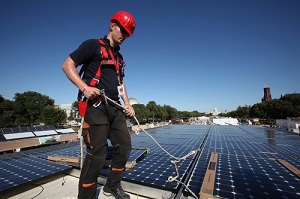Reviewing last week's solar energy news
 Apparently The Rapture didn’t happen this weekend, or maybe we missed something. Otherwise, one of the most pressing issues in the U.S. solar industry is developing a national policy to incentivize solar while working to draw down carbon dioxide. Unfortunately, the amount of political will that such a feat requires needs some serious boosting. Thankfully, think tanks and others are working on such policy.
Apparently The Rapture didn’t happen this weekend, or maybe we missed something. Otherwise, one of the most pressing issues in the U.S. solar industry is developing a national policy to incentivize solar while working to draw down carbon dioxide. Unfortunately, the amount of political will that such a feat requires needs some serious boosting. Thankfully, think tanks and others are working on such policy.
Last week, the Brookings Institution’s Hamilton Project released a number of strategies for clean energy policies that would both increase the amount of solar and wind power in the U.S., and draw down the amount of fossil fuel generation in the country. The forum also featured energy industry leaders and environmental leaders.
It’s not like the U.S. is doing nothing at this point, however. The government continues to unveil new campaigns to speed the adoption of solar and clean energy technologies. Vice President Joe Biden was on-hand at the National Renewable Energy Laboratory (NREL) to unveil the winner of the first “America’s Next Top Energy Innovator”. A patent discount program allowing start-ups and established companies access to patents developed by the U.S.’ national labs for $1,000 each. Boulder-based e-Chromic LLC, which is working to bring a new electrochromic window technology, was the first winner.
The U.S. also is continuing to support the solar industry in other ways as well. Last week, First Solar, Inc. (Nasdaq: FSLR ) announced that three of its large-scale projects remain in the Department of Energy’s 1705 loan-guarantee program, under which the company can get the support of the federal government to help attract lower-rate financing for its projects. However, that program is sun-setting.
The U.S. still remains a leading innovator in the solar industry. For instance, the University of Colorado is on the edge of pioneering an inexpensive method of using sunlight to split water into hydrogen and oxygen. It’s working to create a usable, transportable energy source that could power tomorrow’s electric vehicles with fuel cells, while also providing clean drinking water.
As the amount of solar manufacturing equipment out there continues to increase, it helps drive down the cost of solar. And GT Solar International, Inc. (Nasdaq: SOLR), which manufactures production equipment for polysilicon-based solar products, LEDs and other specialty markets, has sold a lot of production equipment lately. Since April 25, it’s seen $716.1 million in new sales since April 25.
Concentrating photovoltaics (CPVs) are also making inroads. Last week two leading CPV companies, Amonix and Soitec, made the headlines. Amonix announced that its new manufacturing plant in North Las Vegas has opened. Meanwhile Soitec inked new deals with San Diego Gas & Electric (SDG&E). Soitec, a French company, will soon build its first North American manufacturing facility in SDG&E’s service area, and it has a project pipeline of 305 megawatts all of which will be sold SDG&E.
One of the largest markets in solar is the residential market. But it’s still hard to make solar accessible to most people. To make it easier, Sungevity partnered with home improvement company, Lowes. Lowes will host Sungevity iQuote kiosks in certain markets across the U.S.
In lieu of strong federal policy, states are working to increase the adoption of renewables locally. For instance, Vermont’s energy leaders discussed developing a smart grid in the state that can handle the adoption of renewable energy more readily than it’s currently able. In Georgia, Gov. Nathan Deal (R) signed into law a doubling of funds for the Solar Investment Tax Credit, which as of January 2012, will annually offer a total of $5 million to home and building owners to install solar starting in January 2012 and going through December 2014.
In a collaborative venture with the New Mexico Green Chamber of Commerce, SunPower Corp. agreed to offer rebates to member employs as well as the members themselves. Employees can receive rebates of up to $2,000 and businesses, $10,000.



